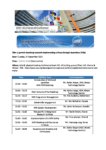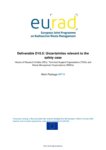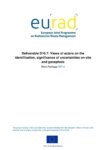Key Topic 4: Implementation and Optimisation
Overview
The future development of reactor, fuel cycle and waste management technologies and policies and the long duration of disposal development (several decades) will inevitably raise opportunities and needs for changes and adaptations in the design, implementation, construction and operation of geological repositories. Some of the future likely trends are already visible and may be reflected in adaptable and flexible designs and implementation schemes.
Construction of a repository will involve successive stages of construction operations with gradual implementation of the various technologies used for the disposal and surface facilities (including a pilot phase or pilot demonstrator(s)). This step-wise implementation allows continuous optimisation, flexibility and adaptation:
- Optimisation concerns technical and economic aspects, but also increases in the robustness of post-closure safety demonstration and/or operational safety.
- Flexibility concerns adapting the repository design and programme over time to address uncertainties that exist at the licensing application stage (e.g. if necessary, defining different design options to allow for inventory uncertainty). The need for flexibility particularly relates to possible variations in waste delivery, reception flows, packaging modes and processes, disposal modes for radioactive waste packages, waste inventory management of current nuclear power plant (increase of operating duration), etc.
- Adaptability concerns the ability of the repository design and programme to adapt over time, for example, to the disposal of waste not provided for in its inventory at the licensing application stage or to modification of requirements or design criteria.
Of course, the importance each WMO places on adaptability and flexibility in their disposal programme depends on their national context (e.g. national policy in terms of reprocessing of spent fuel or not, policies in terms of evolution of the current/future nuclear fleet, etc.) and associated radioactive waste inventory.
The design strategy has to be “optimised”, taking into account the potential benefits of increased adaptability and flexibility versus management of uncertainties in the future, including assessment of the cost impacts of such adaptability and flexibility. This research area deals with the integration of new developments during the lifetime of a geological repository (construction and the operation time up to closure). A licence would be issued for constructing and operating a geological repository on the basis of the available information at the time of the application. However, during the operational lifetime of a geological repository from its construction to its closure, new technologies, new scientific findings or improvements, and changes in the radioactive waste inventory, are likely to occur and can also be considered for the future closure, as well as for any reversibility and retrievability rationale [i].
Adaptation and flexibility will be ongoing throughout the lifetime of the repository from the reference layout, through design (including adaptation to the site), and during construction and operation. This supports the gradual development of a repository that may include a pilot phase or a pilot demonstrator in many design strategies.
[i] OECD (2012). Reversibility of Decisions and Retrievability of Radioactive Waste Considerations for National Geological Disposal Programmes, NEA No. 7085.
Objective
The research area aims to ensure that a higher level of safety, or at least the same level as that demonstrated for the initial licence (taking into account the entire waste lifecycle), is achieved through adaptation and flexibility, independent of the new developments or new inputs (such as change of radioactive waste inventory) related to the repository over time.
A geological repository should take account of new developments in order to adapt and to optimise its construction, operation and closure, particularly in concert with feedback from operation. Improving industrial conditions is expected to simplify the work and to improve quality and safety (both during operations and post-closure) and, at the same time, potentially reduce the costs. This holistic approach has to take into consideration the long timescale of repository development, particularly for cost assessment. Therefore, research with these objectives contributes to the second pillar, “Optimise and Industrialise”, of the 2040 Vision.
Related Documents
MIND Project Annual Meeting 4 (May 2019) – Short Abstracts
Description: Short Abstracts from the MIND Project 4th (final) Annual Meeting (Stockholm, May 7-9 2019).
Last updated: July 31, 2019
IGD-TP Vision 2040 and Strategic Research Agenda
Description: IGD-TP Vision 2040 and Strategic Research Agenda, published September 2020 (reference error corrected on 26/09/2022)
Last updated: October 7, 2020
IGD-TP Symposium and Webinar 2022 – First Announcement
Description: IGD-TP Symposium and Webinar 2022 - First Announcement (26 April 2021)
Last updated: April 26, 2021
2021-08 IGD-TP Symposium How to Get to SixConventionPoint
Description: IGD-TP Symposium, How to get to SixConventionPoint, August 2021
Last updated: August 19, 2021
2021-09 IGD-TP Symposium and Webinar – Draft Agenda
Description: IGD-TP Symposium, Draft Agenda, September 2021
Last updated: September 9, 2021
IGD-TP Symposium and Webinar 2022 – Second Announcement and Call for Posters
Description: IGD-TP Symposium and Webinar 2022 - Second Announcement (10 September 2021)
Last updated: September 10, 2021
2021-09-IAEA-65th General Conf Side event-A generic Roadmap towards implementing a DGR
Description: 65th IAEA General Conference, Side event "A generic Roadmap towards implementing a Deep Geologic Repository (DGR)", Flyer, September 2021
Last updated: September 16, 2021
2022-03 IGD-TP Symposium and Webinar – Draft Agenda
Description: IGD-TP Symposium, Draft Agenda, March 2022
Last updated: April 3, 2022
2022-04 IGD-TP Symposium and Webinar – Draft Agenda
Description: IGD-TP Symposium, Draft Agenda, April 2022
Last updated: April 12, 2022
PREDIS – M2.3: Baseline Strategic Research Agenda
Description: Milestone 2.3 of the PREDIS project: "Baseline Strategic Research Agenda"
Last updated: June 16, 2022
Description: Deliverable 2.2 of the PREDIS project: "Gap analysis"
Last updated: June 16, 2022
PREDIS – D7.1: State of the Art in packaging, storage, and monitoring of cemented wastes
Description: Deliverable 7.1 of the PREDIS project: "State of the Art in packaging, storage, and monitoring of cemented wastes"
Last updated: June 16, 2022
PREDIS – D7.2.2: Reference package and factors affecting package evolution and degradation
Description: Deliverable 7.2.2 of the PREDIS project: "Reference package and factors affecting package evolution and degradation"
Last updated: June 16, 2022
PREDIS – MS14: LCA and LCC protocol guidance
Description: Milestone 14 of the PREDIS project: "LCA and LCC protocol guidance".
Last updated: June 16, 2022
PREDIS – MS1: End user seminars
Description: Milestone 1 of the PREDIS project: "End user seminars".
Last updated: June 16, 2022
PREDIS – D3.6: Priority list and mobility formats
Description: Deliverable 3.6 of the PREDIS project: "Priority list and mobility formats, depending on the priorities identified and approved within PREDIS".
Last updated: June 16, 2022
PREDIS – D3.4: Design and Definition of PREDIS training program (WP3)
Description: Deliverable 3.4 of the PREDIS project: "Design and Definition of PREDIS training program (WP3)".
Last updated: June 16, 2022
PREDIS – D1.5: Proceedings of PREDIS May Workshop 2021
Description: Deliverable 1.5 of the PREDIS project: "Proceedings of PREDIS May Workshop 2021".
Last updated: June 16, 2022
PREDIS – D2.4: International approaches to establishing a waste acceptance system
Description: Deliverable 2.4 of the PREDIS project: "International approaches to establishing a waste acceptance system".
Last updated: June 16, 2022
Description: Deliverable 9.12 of the EURAD/ROUTES project: "Studies and plans for developing shared solutions for radioactive waste management in Europe"
Last updated: June 16, 2022
Description: Deliverable 9.16 of the EURAD/ROUTES project: "Implementation of the ROUTES ICS action plan first phase - CS discussion and input focused on the first topic identified in the ICS action plan"
Last updated: June 16, 2022
Description: Deliverable 9.4 of the EURAD/ROUTES project: "Overview of existing work on categorization/classification of RWs in participating states"
Last updated: June 16, 2022
EURAD/ROUTES – D9.15: Scoping of ROUTES, Initial ICS Input and ICS Action Plan
Description: Deliverable 9.15 of the EURAD/ROUTES project: "Scoping of ROUTES, Initial ICS Input and ICS Action Plan"
Last updated: June 16, 2022
EURAD/UMAN D10.10: UMAN – Analysis and description of groups of different actors
Description: EURAD/UMAN Deliverable 10.10: "UMAN - Analysis and description of groups of different actors".
Last updated: June 17, 2022
2022-09 IGD-TP Symposium and Webinar – Programme and Abstracts
Description: IGD-TP Symposium and Webinar, Programme and Abstracts, September 2022 (v3)
Last updated: September 3, 2022
UMAN Deliverable 10.1: Training materials
Description: This report contains the aims, the learning outcomes and the description of the training course organised by the Work Package UMAN on February 14-16 2023 at Bel V (Brussels, Belgium). The report also contains abstracts of the lectures, the slides prepared and presented by each lecture, a career summary of these lecturers and the test organised at the end of the training course.
Last updated: February 13, 2025
UMAN Deliverable 10.2: Generic strategies for managing uncertainties
Description: This report presents the findings of Sub-Task 2.1 of the UMAN work package of EURAD project. UMAN is focused on developing a common understanding among European Waste Management Organisations (WMOs), Technical Support Organisations (TSOs) and Research Entities (REs) and civil society of strategies and approaches for managing uncertainties by sharing knowledge and identifying remaining and emerging issues. Sub-Task 2.1 is focused specifically on identifying generic strategies for managing uncertainties. The Sub-Task 2.1 work has largely drawn on responses from WMOs, TSOs and REs to a questionnaire produced for the UMAN project to facilitate information gathering.
Last updated: February 13, 2025
UMAN Deliverable 10.3: Uncertainty identification, classification and quantification
Description: This deliverable is specifically related to Subtask 2.2 “Uncertainty identification, classification and quantification”, which deals with approaches to identify and classify uncertainties that might be of relevance in the various stages of radioactive waste management as well as on the quantification of numerical uncertainties.
Last updated: February 13, 2025
UMAN Deliverable 10.4: Methodological Approaches to Uncertainty and Sensitivity Analysis
Description: This report presents the findings of the EC UMAN project regarding to methodological approaches used in the uncertainty and sensitivity analysis. The work also includes examples of the application of different methods to existing sets of probabilistic PA calculations. The major input to this report comes from a dedicated UMAN questionnaire.
Last updated: February 13, 2025
UMAN Deliverable 10.5: Uncertainties relevant to the safety case
Description: This report assesses the views of different actors, principally of waste management organisations, technical safety organisations and research entities on the uncertainties in a safety analysis and in a safety case for geological disposal of radioactive waste and how the uncertainties may evolve over time.
Last updated: February 13, 2025
Description: This UMAN WP deliverable D 10.6 presents the views of the different actors on the identification, characterization and potential significance of uncertainties related to waste inventory. Information contained in this deliverable provides input to the work performed in Subtask 4.2 on possible uncertainty management options, as well as to Task 5 dedicated to interactions within a broader group of actors including civil society.
Last updated: February 13, 2025
Description: Compilation of views of actors on the identification, significance of uncertainties on site and geosphere
Last updated: February 13, 2025
Description: The report presents the description of the human-related uncertainties, synthetizing the results from the various inputs with a focus on the ten main uncertainties associated with the following topics and considered as of high-priority for further investigation, i.e.: • A: Process for the identification of a workable set of repository requirements • B: Continuity of the waste management policy along political changes • C: Robustness of the presently considered safety requirements with regard to the long term • D: Public acceptance of the repository at potentially suitable or projected location • E: Schedule to be considered for implementing the different phases of the disposal programme • F: Robustness of the safety case vis-à-vis sociotechnical factors • G: New knowledge • H: Adequacy of safety-related activities (in siting, design, construction, operation and closure) for the implementation of (operational and long-term) safety provisions • I: Robustness of safety vis-à-vis possible cyber-attacks or programming errors • J: Availability of well-educated human resources, and relevant experts in radioactive waste management along the repository lifetime until closure
Last updated: February 13, 2025
Description: This EURAD deliverable 10.9 focuses primarily on the analysis of uncertainties significance from the point of view of the three categories of actors (WMOs, TSOs and REs).
Last updated: February 13, 2025
Description: This report focusses on providing a comprehensive overview about different approaches and uncertainty management options to assess and, where is possible and relevant, to reduce risks and optimise safety.
Last updated: February 13, 2025
UMAN Deliverable 10.12: Preferences of different actors on uncertainty management
Description: This report synthetises the four UMAN workshops which focused on the views of the actor’s groups on safety significance of the topical uncertainties and its evolution over the programme phases, preferred uncertainty management options and strategies, potential future joint activities and initiatives, including research and development, strategic studies and knowledge management.
Last updated: February 13, 2025
UMAN Deliverable 10.13: Understanding of uncertainty management by the various stakeholders
Description: This report provides information about the work carried out in UMAN Task n°5 - Interactions between all categories of actors, including Civil Society in the frame of Subtask 5. 1 – Preparation, support and reporting of pluralistic analyses, topic 1: Meaning for different actors of uncertainty management and of its relationships with risk, safety and the safety case. Various inputs were used for Topic 1 but the central instrument was a seminar held on 26-27 October 2020 (“UMAN seminar 1. What does uncertainty management mean for different types of actors and how is it related to risk, safety and the safety case?”). The report provides a description and interpretation of the seminar.
Last updated: February 13, 2025
UMAN Deliverable 10.14: Pluralistic analysis of site and geosphere uncertainty
Description: This report provides information about the work carried out in UMAN Task n°5 - Interactions between all categories of actors, including Civil Society in the frame of Subtask 5. 1 – Preparation, support and reporting of pluralistic analyses. Initially, it was planned to organize discussions of Seminar 2 on Topic 2 (uncertainty pictures at different steps of geological disposal programme) and Seminar 3 on Topic 3 (uncertainty management options for addressing uncertainties throughout a disposal programme). As it is a continuous process, Task 5 adapted the initial planned to take into account the results of seminar 1.
Last updated: February 13, 2025
UMAN Deliverable 10.15: Pluralistic analysis of uncertainty related to human aspects
Description: This deliverable provides information about the work carried out in UMAN Task n°5 - Interactions between all categories of actors, including civil society in the frame of Subtask 5. 1 – Preparation, support and reporting of pluralistic analyses. Task 5 adapted the initial work plan and focused in seminar 3 on human related uncertainties. In this seminar, actors’ views on these uncertainties and the management options for the most safety significant uncertainties were discussed together.
Last updated: February 13, 2025
UMAN Deliverable 10.17: Synthesis report of WP UMAN outcomes from a civil society point of view
Description: This report provides a synthesis of the work carried in UMAN Subtask 5.2 – Input of civil society experts – in the frame of UMAN Task n°5 – Interactions between all categories of actors, and its main outcomes from a civil society point of view. The views of civil society on WP UMAN results were collected and developed in depth through five seminars.
Last updated: February 13, 2025
Description: This deliverable analyses the views of the three categories of actors collected via the new UMAN Questionnaire on near-field uncertainties, launched on April 5, 2022. It includes also the results of Task 3.6 Workshop held at RATEN, Romania 24-25 November 2022, where the replies to the questionnaire and the SotAs of CONCORD and MAGIC have been presented and discussed. In addition, discussion within Seminar 5 (at BelV, Brussels 06-07 December 2023) were taken into account, where CS representatives joint the discussion on near-field uncertainties with WMOs TSOs and REs.
Last updated: February 13, 2025
Description: This report presents the aspects of management of near-field uncertainties as investigated in Subtask 4.2 as well as in the 5th Workshop of Subtask 4.3.
Last updated: February 13, 2025
Description: This report provides information about the work carried out in UMAN Task n°5 - Interactions between all categories of actors, including civil society in the frame of Subtask 5. 1 – Preparation, support and reporting of pluralistic analyses, topic 4: Methods that can be used for discussing and organizing pluralistic assessments of uncertainties with civil society stakeholders throughout a disposal programme. Various inputs were used for topic 4, but the central instrument was a seminar held on 14-15 December 2022 (“UMAN seminar 4. How to manage uncertainties in a pluralistic way and in a long-term perspective?”). This report provides a description and interpretation of the seminar.
Last updated: February 13, 2025
Description: This report provides information about the work carried out in UMAN Task n°5 - Interactions between all categories of actors, including Civil Society in the frame of the extension of Subtask 5.1 – Preparation, support and reporting of pluralistic analyses. Existing Task 5 have been extended to test with a broader stakeholder group including civil society the methods identified by UMAN Task 5 (and more especially during UMAN Seminar 4) for a pluralistic assessment of uncertainties and their management, using near-field uncertainties as case study.
Last updated: February 13, 2025
ROUTES Deliverable 9-1: Training materials
Description: Training material from a EURAD (European Joint Programme on Radioactive Waste Management) and PREDIS (Pre-disposal management of radioactive waste) joint Summer School on Waste Acceptance Criteria (WAC) for radioactive waste. The training took place in September 4-8, 2023.
Last updated: February 13, 2025
Description: This report presents the identified Research and Development (R&D), Strategic Studies (StSt) and Knowledge Management (KM) needs and opportunities for collaboration between Member States, and details the recommendations as a result of the insights and achievements obtained from the deliverables and milestones generated in ROUTES tasks.
Last updated: February 13, 2025
ROUTES Deliverable 9-5: Overview of issues related to challenging wastes
Description: This deliverable presents the main outcomes of the ROUTES Subtask 2.2 meetings, detailing the major difficulties at stake for each challenging waste and initiatives that have been implemented by some Member States.
Last updated: February 13, 2025
Description: The objective of this deliverable is a comprehensive description of radioanalytical characterisation, including • the identification of characterisation techniques, • the comparison of characterisation methods applied for the same waste in different countries, • the analysis of existing approaches and identification of knowledge gaps, as well as • to give recommendations both for future research and development (R&D) tackling the identified knowledge gaps and for characterisation approaches for countries with non-developed waste management concepts.
Last updated: February 13, 2025
ROUTES Deliverable 9-8: Review of characterisation of legacy and historical wastes
Description: The aim of Task 3 of ROUTES is to identify techniques for characterisation, to compare the methods applied in different countries, to identify knowledge gaps and give recommendations for future R&D. This report summarises the results gained in work on the second subtask of Task 3 on characterisation and segregation of legacy waste.
Last updated: February 13, 2025
Description: The present report is the sole deliverable documenting the work performed under ROUTES Task 4. It summarises the outcomes of ROUTES Subtasks 4.1, 4.2 and 4.3, namely: • Current use of WAC in Member States and some Associated Countries. • Key discussion points from the Subtask 4.2 workshop titled “Sharing experience on waste management with / without WAC available” held on 14-15 June 2021. • The results of a gap analysis performed following the workshop including a series of observations and recommendations aimed at supporting the progression of waste management activities when uncertainties remain regarding future stages in the waste lifecycle, particularly disposal end points, and/or when associated WAC are absent. • Key discussion points from the Subtask 4.3 workshop titled “R&D needs and opportunities for collaboration” held on 10 May 2022. • The process for identifying, screening and prioritising commonly held WAC-related R&D needs and the opportunities for potential future collaboration between Member States and Associated Countries on this topic.
Last updated: February 13, 2025
Description: The aim of this report is to compile the existing knowledge on the various options for the final disposal of radioactive waste that could be used for small amounts of waste.
Last updated: February 13, 2025
Description: This second deliverable of Task 5 focuses on the necessary predisposal routes including pre-treatment, treatment and conditioning of RAW for the disposal options for SIMS. The aim of this report is to compile the existing knowledge, shared during the workshop in January 2022 (month 32 of EURAD) of this subtask.
Last updated: February 13, 2025
ROUTES Deliverable 9-13: Case studies on shared solution between Member states
Description: This deliverable gathers case studies on shared solutions between Member States in different stages of the waste lifecycle. In this document, shared solutions are defined as knowledge sharing and the sharing of facilities/technologies.
Last updated: February 13, 2025
Description: This report identifies promising topics and waste streams that could lead to opportunities for collaborative solutions between member states.
Last updated: February 13, 2025
Description: In this deliverable the results of the investigations are provided, including comments, suggestions, questions, and other observations collected in interaction with EURAD participants and the Civil Society larger group.
Last updated: February 13, 2025
Description: Implementation of ROUTES action plan third phase; Report of Task 7 on Interaction with Civil Society (ICS); Short term and long-term public participation in RWM technical topics
Last updated: February 13, 2025
ROUTES Deliverable 9-19: Synthesis of Task 7 activities
Description: Deliverable 9.19 “Synthesis report of Task 7 activities” aims to provide summary of the ROUTES Task 7 activities on interaction with Civil Society.
Last updated: February 13, 2025
Description: This report includes the results of Subtask 8.1, which aims at assessing the existing predisposal routes for SIMS based on the input of two workshops held in January 2022 (M30) and May 2022 (M34).
Last updated: February 13, 2025
Description: Summary report on analysis, assessment and evaluation of disposal options for SIMS (taking into account both potential disposal options and predisposal routes) including Annex: Case studies on typical waste pathways.
Last updated: February 13, 2025
CONCORD Deliverable 15-1: Initial State-of-the-art of WP ConCorD
Description: This report provides a review of the current state of the knowledge on the corrosion behaviour of candidate container materials for the disposal of spent fuels (SF) and high-level radioactive waste (HLW).
Last updated: February 14, 2025
CONCORD Deliverable 15-2: Updated State-of-the-art of WP ConCorD
Description: In this report the different aspects concerning the degradation of nuclear waste containers and the technological approaches for a better performance are summarized.
Last updated: February 14, 2025
CONCORD Deliverable 15-3: Training materials
Description: This report provides an overview of presentations that can be used as training materials related to the ConCorD WP.
Last updated: February 14, 2025
CONCORD Deliverable 15-4: Updated Training materials
Description: The outline and learning outcomes for each of the topics of the ConCorD training course is given in this report.
Last updated: February 14, 2025
Description: Novel materials and processes for the optimisation of long-term container performance
Last updated: February 14, 2025
CONCORD Deliverable 15-7: Elucidation of critical irradiation parameter
Description: This document is deliverable 15.7 of the EURAD WP15 ConCorD and aims to elucidate the critical parameters associated with radiation exposure when considering the corrosion performance of candidate canister materials for deep geological disposal of radioactive waste.
Last updated: February 14, 2025
CONCORD Deliverable 15-8: Synthesis of irradiation results under repository conditions
Description: The objective of the present report was the assessment of irradiation-accelerated corrosion of canister materials in realistic environments and irradiation conditions.
Last updated: February 14, 2025
Description: Integration of the findings on the impact of irradiation, dry density and particle size on the microbial community
Last updated: February 14, 2025
Description: In this report, the results of a 1.5-year-long borehole incubation experiment aimed at evaluating the persistence of oxygen in bentonite under anoxic conditions are presented.
Last updated: February 14, 2025
CONCORD Deliverable 15-12: Identification of the effect of transient processes on corrosion
Description: This document is deliverable 15.12 of the EURAD WP15 ConCorD and gathers the experimental studies carried out within Task 5, aimed to identify the role of transient conditions on corrosion of materials selected for disposal canisters in deep geological repositories for high-level radioactive waste.
Last updated: February 14, 2025
CONCORD Deliverable 15-14: ConCorD Synthesis Report
Description: The aim of the this synthesis report was to draw together a summary of the work carried out in the various tasks of the project and to identify the key aspects and outcomes that may be applied in the preparation of future performance assessments and safety cases by the national waste management organisations.
Last updated: February 14, 2025
IGD-TP Exchange Forum 2025 – First Announcement
Description: IGD-TP Exchange Forum 2025 - First Announcement (14 March 2025)
Last updated: March 14, 2025
Related Activities
- development of guidelines on assessing the consequences of any change on the overall disposal system;
- development of methodology on future integration of adaptions; and
- identification of disposal system components that, through adaptation and optimisation, would potentially reduce over-conservatism, improve quality and simplify design, construction and operations.
ARGONA

ESDRED









































































